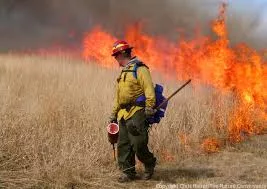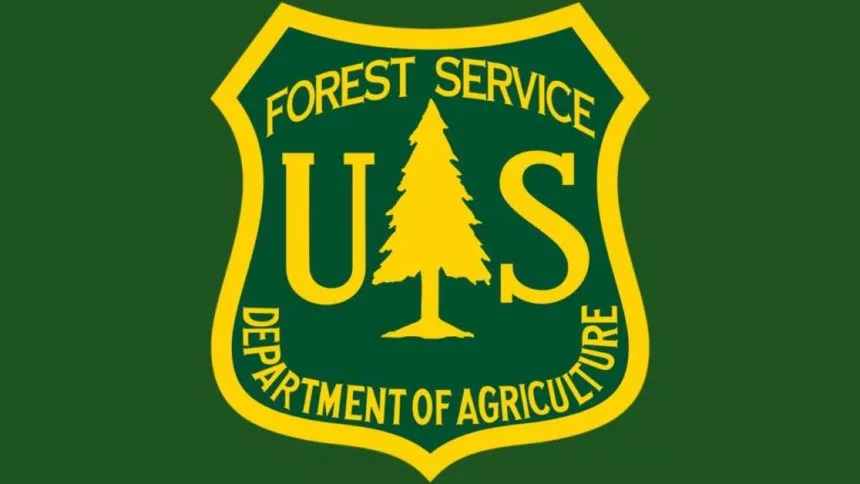Deschutes National Forest firefighters plan to start spring prescribed burning season in mid-April as conditions become favorable. The Deschutes National Forest may accomplish up to an estimated 11,000 acres of prescribed burning, including up to an estimated 7,000 acres on the Bend-Fort Rock Ranger District, 1,271 acres on the Crescent Ranger District and 2,942 acres on the Sisters Ranger District.
Prescribed burns are slated for the following areas: Bend – west of Bend adjacent to the Cascade Lakes Highway, Forest Service Road (FSR) 41 and the Deschutes River; and southeast of Bend near the FSR 18 and 25 junction and on the northern portions of Pine Mountain, Crescent – south of the Two Rivers subdivision and west of Highway 97; south of Crescent, east and west of Highway 97 and north of Highway 58, La Pine – northeast of La Pine along the north and south sides of Paulina Lake Road; east of La Pine near Fox Butte; and southeast of La Pine adjacent to Highway 31, Sisters – north of Sisters on the east and west sides of Highway 20 just south of Indian Ford Campground; within the Metolius Basin including along the eastern side of (FSR) 14 and just north of the Camp Sherman on the eastern side of FSR 14; and generally west of Sisters. Sunriver: east of Sunriver on the west and east sides of Highway 97 near the South Century Drive interchange and along the south side of South Century Drive leading into Sunriver from Highway 97. Please see maps for more information on specific locations.
Firefighters implement understory prescribed burning to reduce wildfire risk to communities. Prescribed burning reintroduces and maintains fire within our fire-dependent ecosystem by removing concentrations of vegetation and restoring forest health while increasing public and firefighter safety. Once firefighters ignite prescribed burns, they monitor and patrol the units until they declare the burn out.
Prescribed burns, which are primarily conducted in spring and fall, are carefully planned and implemented under specific conditions of temperature, wind, humidity and vegetation moisture. Firefighters work with Oregon Department of Environmental Quality and Oregon Department of Forestry smoke forecasters to identify conditions that will minimize smoke impacts on people and communities. While prescribed fire managers take significant preventive measures, it’s likely that communities may experience some smoke during or immediately after a prescribed burn. Most smoke impacts occur during the night and early morning hours.
For more information on prescribed burning and smoke preparedness in Central Oregon, visit centraloregonfire.org/ and for information specific to the Deschutes National Forest visit www.fs.usda.gov/deschutes. Visit centraloregonfire.org/prescribed-fire-smoke-plans/ to view an interactive map with planned burn locations. Text “COFIRE” to 888-777 to receive prescribed burn and wildfire text alerts. Follow along on X/Twitter @CentralORFire.
This work is occurring within the Central Oregon Landscape, one of 21 focal landscapes identified within the Forest Service’s Wildfire Crisis Strategy. The implementation of this work supports the Deschutes National Forest’s commitment to addressing the Wildfire Crisis Strategy which aims to reduce severity of wildfires, protect communities, and improve the health and resiliency of fire-dependent forests.
Your local public health departments serving Central Oregon (Deschutes, Jefferson, and Klamath Counties) have resources to help protect our community from smoke. The start of prescribed burn season brings potential for smoke in and around homes and communities. While prescribed burns are a key tool to protect the community, smoke from prescribed burns can reduce air quality and harm health.
Your local Public Health Department (Deschutes, Jefferson, and Klamath Counties) offers easy ways for you to recognize and protect yourself from poor air quality that may result from prescribed burns this spring. It is a good time to get ready now, before wildfire season begins and smoke impacts could happen at any time.
“Smoke from prescribed fires and wildfires contains fine particles that can cause respiratory symptoms when you inhale smoky air. People at the highest risk for developing smoke-related illness are those with chronic lung or heart conditions, older adults, and children,” said Dr. Richard Fawcett, Deschutes County Health Officer. “People with asthma or other lung conditions should keep their medications on hand, and contact their medical provider should they develop persistent or more frequent respiratory symptoms.”
“We know people are concerned about smoke in their environment,” said Director Jennifer Little of Klamath County Public Health. “That’s why we have a GIS map on our website to indicate where prescribed burns are happening that might affect Klamath County.”
The map can be found at https://www.klamathcounty.org/1243/AQI-Air-Conditions. It provides a visual representation of where fires are occurring and the current air quality index.
Public Health suggests people take the following steps to avoid breathing problems or other symptoms when smoke is present from prescribed burns or wildfires:
- The number one recommendation for everyone is to limit your exposure to wildfire smoke. Older adults, young children, and people with heart or lung conditions are more sensitive to smoke.
- During prescribed burn season, be sure to close your windows at night, as highest concentrations of smoke tend to occur overnight and during the early morning hours.
- Check the current air quality for your area at www.fire.airnow.gov/. Avoid areas with highest smoke levels (AQI 150+).
- Avoid strenuous outdoor activity when smoke is heavy. Use the air quality index to decide whether outside activities are safe for you and your family: https://www.airnow.gov/aqi/aqi-basics/.
- Stay indoors with windows and doors closed when smoke is heaviest. Use a filter in your heating and cooling system that removes fine particles.
- Building a box fan filter is an affordable and effective way to keep indoor air clean: https://vimeo.com/454191902.
- Visit www.211info.org to see when and where cleaner indoor air spaces are available to the public.
- Try to avoid driving in smoky areas. If you need to drive in these areas, keep your windows rolled up and vents closed. Set the air conditioning on “re-circulate.” This will avoid bringing smoke into your car.
- If you must be outside in heavy smoke, consider wearing a NIOSH-approved, N95 mask.
- For more information about how to protect your health from smoke, visit: https://centraloregonfire.org/protect-your-health/





